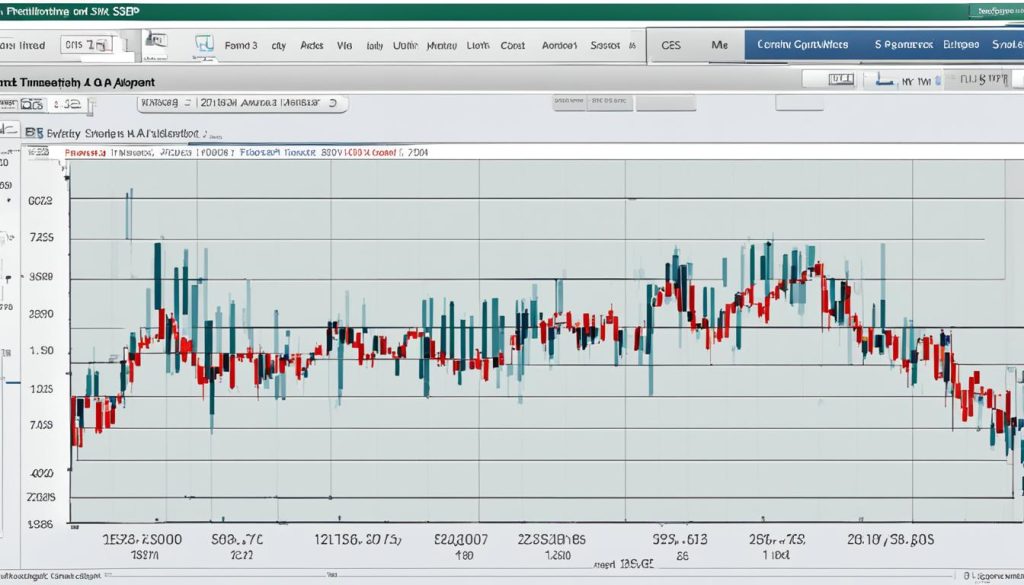Welcome to our beginner-friendly guide on how to invest in the S&P 500, one of the most well-known stock market indexes in the United States. The S&P 500 tracks the performance of 500 large U.S. companies, making it an attractive investment option for individuals looking to diversify their portfolio and potentially earn long-term returns.
While you can’t directly invest in the index itself, there are several strategies you can use to invest in S&P 500 index funds or ETFs, allowing you to replicate the index’s performance and benefit from the growth of these companies.
In this guide, we’ll explore the best strategies for S&P 500 investing, providing you with the knowledge and tools to make informed investment decisions. Whether you’re a beginner or looking to enhance your investment portfolio, this guide will equip you with the essential information needed to get started. Let’s delve into the world of S&P 500 investing and discover how you can make the most of this popular investment opportunity.
The Easiest Way to Invest in the S&P 500
The simplest way to invest in the S&P 500 is through S&P 500 index funds or ETFs. These investment vehicles hold a portfolio of stocks that replicate the companies listed in the index. By investing in these funds, you gain exposure to the performance of the entire S&P 500 index, which represents a wide range of leading U.S. companies.
Investing in S&P 500 index funds or ETFs offers several advantages. First, it provides instant diversification. Rather than choosing individual stocks, these funds allow you to invest in a broad selection of companies across different sectors. This diversification helps to spread out the risk and reduces the impact of any single company’s performance on your investment.
When investing in S&P 500 index funds or ETFs, you can purchase them through a taxable brokerage account or retirement accounts like a 401(k) or IRA. These retirement accounts often offer additional tax benefits, such as tax-free growth or tax deductions. It’s important to consult with a financial advisor or tax professional to understand the specific tax implications and benefits for your situation.
Alternatively, if you prefer to have more control over your investments, you can also choose to invest in individual companies that are part of the S&P 500 index. By carefully selecting specific companies, you can potentially achieve higher returns if those companies outperform the index as a whole. However, it’s worth noting that investing in individual stocks carries higher risk compared to index funds or ETFs.
Ultimately, the choice between investing in S&P 500 index funds/ETFs or individual stocks depends on your risk tolerance, investment goals, and level of involvement in managing your portfolio. Both options can be viable, but it’s important to research and understand the pros and cons of each approach.
Table: Comparing S&P 500 Index Funds and Individual Stocks
| S&P 500 Index Funds | Individual Stocks |
|---|---|
| Instant diversification | Opportunity for higher returns with successful companies |
| Lower risk compared to individual stocks | Higher risk due to concentration in individual companies |
| Easy to track and manage | Requires more research and monitoring |
| Passive investing approach | Active investing approach |
By considering your investment objectives, risk tolerance, and preferences, you can choose the most suitable approach to invest in the S&P 500. Whether you opt for index funds, ETFs, or individual stocks, investing in the S&P 500 provides an opportunity to participate in the growth of the U.S. economy and potentially achieve long-term financial success.
How to Invest S and P 500?
Opening an Investment Account
If you’re interested in investing in the S&P 500, the first step is to open an investment account. This will provide you with a platform to buy and hold S&P 500 index funds or individual stocks. If you don’t already have a brokerage account, you can easily open one with a reputable brokerage firm. Here are a few tips to consider when opening your investment account:
- Choose a reputable brokerage firm: Select a brokerage firm that has a strong reputation and offers the services and tools you need for your investment journey. Look for a firm that provides a user-friendly platform and excellent customer support.
- Consider account fees and minimums: Take a close look at the fees associated with the investment account, such as account maintenance fees, transaction fees, or minimum balance requirements. Be sure to choose an account that aligns with your budget and investment goals.
- Research investment analytics tools: Utilize investment analytics tools to track the performance of the S&P 500 and make informed investment decisions. These tools can provide valuable insights and help you monitor the market trends.
Opening an investment account is a vital step in your journey towards investing in the S&P 500. It provides you with the necessary tools and resources to manage your investments effectively. Take the time to choose the right brokerage firm and familiarize yourself with the available investment analytics tools.

Choosing Your Investments
Once you have an investment account, you’ll need to decide on the smartest ways to invest in the S&P 500. There are two primary options: S&P 500 index funds and individual stocks.
1. S&P 500 Index Funds:
Investing in S&P 500 index funds is a popular and smart strategy. These funds provide instant diversification by holding a portfolio of stocks that replicate the companies listed in the index. By investing in an S&P 500 index fund, you can track the performance of the entire index and benefit from the overall market growth. This approach is generally considered less risky compared to investing in individual stocks.
By allocating a portion of your portfolio to an S&P 500 index fund, you can achieve broad market exposure and reduce the risk associated with investing in a single company. This is particularly beneficial for long-term investors who prioritize stability and consistent returns over time.
2. Individual Stocks:
If you’re willing to take on more risk and have a keen interest in specific companies within the S&P 500, investing in individual stocks can be an attractive option. While this approach offers more control and the potential for higher returns, it also requires extensive research, analysis, and the ability to react to market fluctuations.
When selecting individual stocks, consider the company’s financial health, growth prospects, competitive advantages, and industry trends. Diversification is key, so it’s crucial to invest in a variety of companies across different sectors to mitigate risk.
Comparing S&P 500 Index Funds vs. Individual Stocks:
| S&P 500 Index Funds | Individual Stocks |
|---|---|
| Provides instant diversification | Requires diligent research and analysis |
| Tracks the performance of the entire index | Subject to individual company performance |
| Generally considered less risky | Carries higher risk, but potential for higher returns |
Ultimately, the choice between S&P 500 index funds and individual stocks depends on your investment goals, risk tolerance, and level of involvement in managing your portfolio. It may also be wise to consult with a financial advisor who can offer personalized guidance based on your unique circumstances.

Purchasing Your Investments
Once you’ve decided on the type of investment you want, whether it’s an S&P 500 index fund or individual stocks, it’s time to make the purchase. If you’re opting for an index fund, you’ll need to choose a specific fund that tracks the S&P 500. Here’s how you can go about it:
Choosing an S&P 500 Index Fund
When selecting an S&P 500 index fund, there are a few factors to consider:
- Expense Ratios: Look for funds with lower expense ratios, as these fees can impact your overall returns. Compare different funds and choose one with a competitive expense ratio.
- Track Record: Review the fund’s historical performance and compare it to the S&P 500 index. Choose a fund that consistently tracks the index closely over time.
- Portfolio Holdings: Examine the holdings of the fund. Ensure that it replicates the companies listed in the S&P 500 index. You can find this information in the fund’s prospectus or on the fund provider’s website.
- Management Team: Research the fund manager and their experience with index fund management. A skilled and experienced team can contribute to the fund’s performance.
Fees Associated with S&P 500 Investing
It’s important to be aware of the fees associated with investing in S&P 500 index funds or individual stocks. These fees can impact your overall investment returns over time. Here are some fees you may encounter:
- Expense Ratios: This fee is charged by the fund provider and is a percentage of your invested amount. It covers the fund’s operating expenses. Look for funds with lower expense ratios to minimize costs.
- Trading Fees: Your brokerage account may charge a fee every time you buy or sell shares of an S&P 500 index fund or individual stocks. Consider the impact of these fees on your investment returns.
- Commission Costs: Some brokers may charge a commission for each trade you make. Be sure to review your broker’s fee schedule and choose a low-cost or commission-free brokerage if possible.
Once you’ve considered these factors and chosen an S&P 500 index fund or individual stocks, follow the instructions within your brokerage account to execute the purchase. Keep in mind that investments involve risk, and it’s essential to monitor your investments regularly and make adjustments as necessary.
In the next section, we’ll explore the performance and profit potential of investing in the S&P 500.

Performance and Profit Potential
Investing in the S&P 500 can provide you with the potential for long-term growth, making it a solid option for retirement investing. The historical performance of the index has consistently shown growth over time, making it an attractive choice for investors seeking capital appreciation.
However, it’s important to consider the risks associated with investing in the S&P 500. Market volatility can lead to fluctuations in the value of your investments, potentially resulting in losses. It’s essential to have a diversified portfolio to mitigate the impact of market downturns.
One of the advantages of investing in the S&P 500 is the opportunity for dividend reinvestment. Many companies in the index pay dividends, which can be reinvested to purchase additional shares. This strategy allows you to compound your returns over time and potentially accelerate the growth of your investment.
To maximize your investment in the S&P 500, it’s crucial to choose the best S&P 500 index funds. These funds aim to replicate the performance of the index and provide instant diversification across 500 large U.S. companies. By investing in the best-performing index funds, you increase your chances of achieving favorable returns.
Below is a table showcasing some of the best-performing S&P 500 index funds available:
| Fund Name | Expense Ratio | Minimum Investment |
|---|---|---|
| Vanguard 500 Index Fund (VFINX) | 0.14% | $3,000 |
| iShares Core S&P 500 ETF (IVV) | 0.03% | None |
| Schwab S&P 500 Index Fund (SWPPX) | 0.02% | $100 |
These funds have consistently delivered strong performance and have low expense ratios, making them popular choices among investors.
It’s important to note that while past performance can provide insights, it does not guarantee future results. The stock market is influenced by various factors, including economic conditions, company performance, and geopolitical events.
Before making any investment decisions, it’s advisable to consult with a financial advisor who can evaluate your individual circumstances and help you determine the best approach for your retirement investment portfolio.

Investing in the S&P 500 from the United Kingdom
UK investors who are interested in investing in the S&P 500 have several options available to them. They can open international brokerage accounts that provide access to global markets, allowing them to invest in the S&P 500 and other international stocks. Alternatively, UK-based platforms also offer access to the S&P 500 and other international markets, making it convenient for UK investors to participate in S&P 500 investing.
One popular choice for UK investors looking to invest in the S&P 500 is through commission-free S&P 500 ETFs. These ETFs allow investors to gain exposure to the S&P 500 without incurring commission fees. Investing in commission-free S&P 500 ETFs can be a cost-effective way to build a diversified portfolio and track the performance of the index.
It’s important for UK investors to consider the currency exchange risks associated with investing in international markets. Fluctuations in exchange rates can impact the performance of investments denominated in different currencies. UK investors should also be aware of the tax implications of investing in international markets and consult with a tax advisor or financial professional to ensure compliance with relevant tax regulations.
Comparison of Commission-Free S&P 500 ETFs for UK Investors
| ETF Name | Expense Ratio | Dividend Yield |
|---|---|---|
| Vanguard S&P 500 ETF | 0.04% | 1.37% |
| iShares Core S&P 500 UCITS ETF | 0.07% | 1.52% |
| SPDR S&P 500 ETF Trust | 0.09% | 1.28% |
These commission-free S&P 500 ETFs offer UK investors the opportunity to invest in a diverse range of companies listed in the S&P 500 index. The expense ratio represents the annual fee charged by the ETF, while the dividend yield indicates the percentage of dividends distributed by the ETF compared to its price.
It’s important for UK investors to carefully research and evaluate the available commission-free S&P 500 ETFs to choose the one that aligns with their investment goals and risk tolerance. Consulting with a financial professional can provide additional guidance and support in selecting the most suitable ETF for their investment portfolio.
Conclusion
Investing in the S&P 500 can be a smart long-term investment strategy, particularly for retirement planning. The S&P 500 has a proven track record of delivering strong returns over time, making it an attractive option for investors seeking growth and wealth accumulation. However, it’s important to evaluate your risk tolerance, investment goals, and diversification needs before committing to this investment.
While the S&P 500 has historically performed well, it’s crucial to remember that past performance is not indicative of future results. Market conditions can fluctuate, and your investments may suffer losses. Therefore, it’s advisable to consult with a qualified financial advisor or conduct thorough research to make informed investment decisions.
As with any investment, the profitability of the S&P 500 varies depending on several factors. These include the time horizon of your investment, market conditions, and your ability to stay invested during periods of volatility. While the S&P 500 has the potential for significant profits, it’s crucial to have realistic expectations and adopt a long-term perspective.
By considering your risk tolerance, conducting thorough research, and seeking professional advice, you can make an informed decision about whether investing in the S&P 500 is suitable for your financial goals. Diversification across multiple asset classes and regular portfolio review are important strategies that can buffer against market fluctuations and help optimize your investment outcomes.
FAQs
What is the difference between S&P 500 index funds and individual stocks?
S&P 500 index funds provide instant diversification and track the performance of the entire index, while investing in individual stocks allows for more control and potential for higher returns.
Can I invest in the S&P 500 if I’m in the United Kingdom?
Yes, UK investors can participate in S&P 500 investing by opening international brokerage accounts or investing through UK-based platforms that offer access to global markets.
Is the S&P 500 a good investment?
The S&P 500 has a track record of delivering strong returns over time and can be a good long-term investment strategy. However, it’s important to consider your risk tolerance and investment goals.
How much profit can I make from investing in the S&P 500?
The profit potential from investing in the S&P 500 depends on various factors such as market conditions and individual investment choices. Past performance is not indicative of future results, so it is important to do thorough research and consider your own financial situation.

